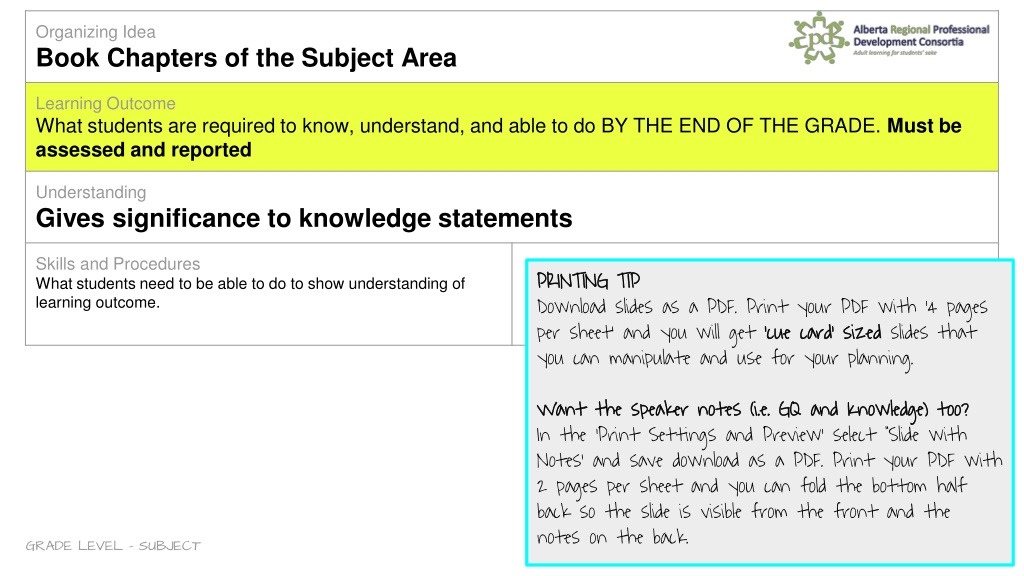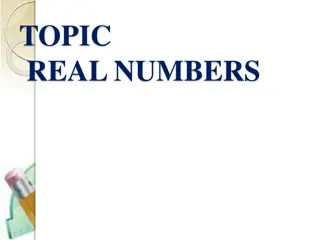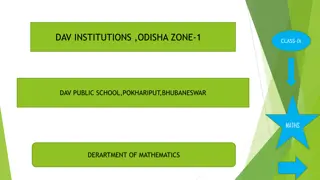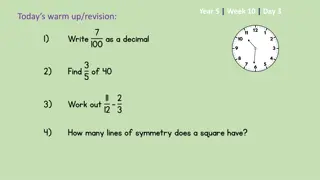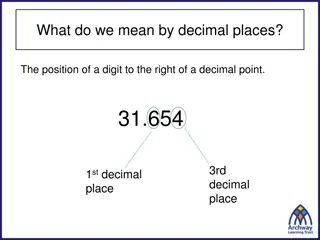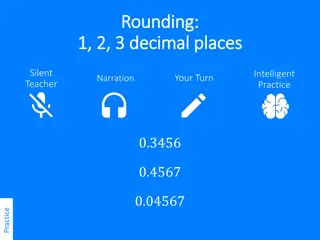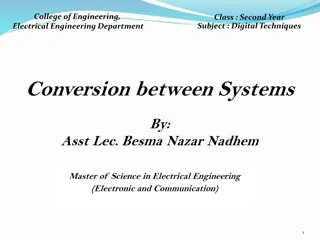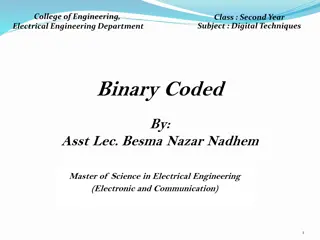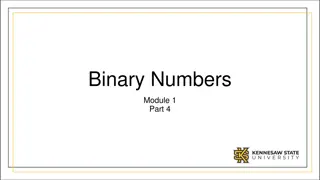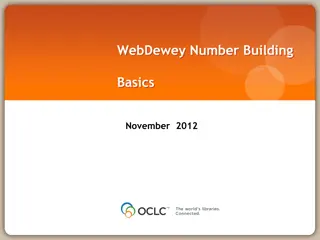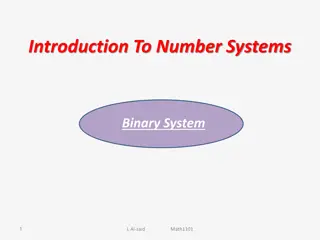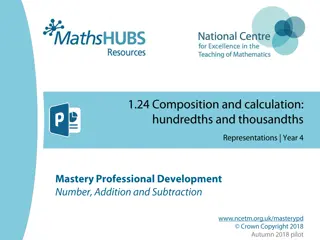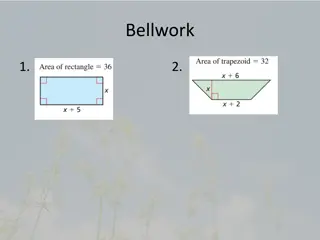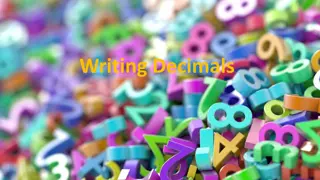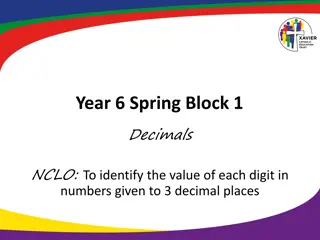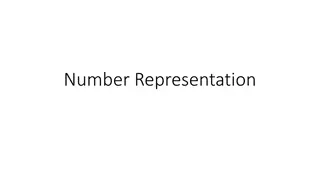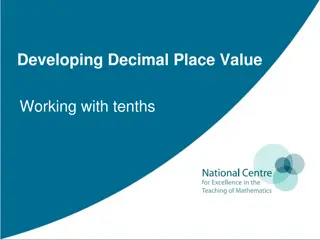Understanding Decimal Numbers and Operations in Mathematics
This educational material focuses on teaching students in a structured manner about decimal numbers and operations within the subject of mathematics. It covers essential topics such as place value, addition, subtraction, prime and composite numbers, and more. Students are required to grasp the significance of decimal numbers, demonstrate skills in identifying place values, performing arithmetic with decimals, and explaining properties of numbers. The content aims to enhance students' mathematical understanding and problem-solving abilities.
Download Presentation

Please find below an Image/Link to download the presentation.
The content on the website is provided AS IS for your information and personal use only. It may not be sold, licensed, or shared on other websites without obtaining consent from the author. Download presentation by click this link. If you encounter any issues during the download, it is possible that the publisher has removed the file from their server.
E N D
Presentation Transcript
Organizing Idea Book Chapters of the Subject Area Learning Outcome What students are required to know, understand, and able to do BY THE END OF THE GRADE. Must be assessed and reported Understanding Gives significance to knowledge statements Skills and Procedures What students need to be able to do to show understanding of learning outcome. PRINTING TIP Download slides as a PDF. Print your PDF with 4 pages per sheet and you will get cue card sized you can manipulate and use for your planning. PRINTING TIP cue card sized slides that Want the speaker notes (i.e. GQ and Knowledge) too? In the Print Settings and Preview select Slide with Notes and save download as a PDF. Print your PDF with 2 pages per sheet and you can fold the bottom half back so the slide is visible from the front and the notes on the back. Want the speaker notes (i.e. GQ and Knowledge) too? UPDATED APRIL 2022 GRADE LEVEL - SUBJECT
Organizing Idea Number: Quantity is measured with numbers that enable counting, labelling, comparing, and operating. Learning Outcome Students apply place value to decimal numbers. Understanding Decimal numbers are numbers between natural numbers. Decimal numbers are fractions with denominators of 10, 100, etc. The separation between wholes and parts, including dollars and cents, can be represented using decimal notation. Patterns in place value are used to read and write numbers, including wholes and parts. Skills and Procedures Identify the place value of each digit in a number, including tenths Express various compositions of a number, including decimal numbers, using place value. and hundredths. Recognize decimal notation expressed in English and in French. Relate the values of adjacent places, including tenths and Round numbers to various places, including tenths. hundredths. Compare and order numbers, including decimal numbers. Express the Determine the value of each digit in a number, including tenths and relationship between two numbers, including decimal numbers, using hundredths. >, <, or = . Express numbers, including decimal numbers, using words and Express a monetary value in cents as a monetary value in dollars numerals. GRADE LEVEL - SUBJECT UPDATED APRIL 2022 using decimal notation.
Organizing Idea Number: Quantity is measured with numbers that enable counting, labelling, comparing, and operating. Learning Outcome Students add and subtract within 10 000, including decimal numbers to hundredths. Understanding Standard algorithms for addition and subtraction may be used for any decimal numbers. Skills and Procedures Add and subtract numbers, including decimal numbers, using standard algorithms. Assess the reasonableness of a sum or difference using estimation. Solve problems using addition and subtraction, including problems involving money. UPDATED APRIL 2022 GRADE LEVEL - SUBJECT
Organizing Idea Number: Quantity is measured with numbers that enable counting, labelling, comparing, and operating. Learning Outcome Students explain properties of prime and composite numbers using multiplication and division. Understanding Different factors can compose the same product. Different products can share factors. A number divided by one of its factors will result in a remainder of 0. Skills and Procedures Determine the factors of a number within 100. Describe a number as prime or composite. Determine the first five multiples of a given number within 100. Recognize the greatest common factor (greatest common divisor) of two numbers within 100. UPDATED APRIL 2022 GRADE LEVEL - SUBJECT
Organizing Idea Number: Quantity is measured with numbers that enable counting, labelling, comparing, and operating. Learning Outcome Students multiply and divide natural numbers within 10 000. Understanding Multiplication and division strategies can be chosen based on the nature of the numbers. Skills and Procedures Recall and apply multiplication number facts, with factors to Examine standard algorithms for multiplication and division. 12, and related division number facts. Multiply and divide 3-digit natural numbers by 1-digit natural Investigate patterns in multiplication and division of natural numbers using standard algorithms. numbers by 10, 100, and 1000. Divide and express a quotient with or without a remainder. Multiply and divide 3-digit natural numbers by 1-digit natural Investigate strategies for estimation of products and numbers using personal strategies. quotients. Assess the reasonableness of a product or quotient using estimation. UPDATED APRIL 2022 Solve problems using multiplication and division. GRADE LEVEL - SUBJECT
Organizing Idea Number: Quantity is measured with numbers that enable counting, labelling, comparing, and operating. Learning Outcome Students apply equivalence to the interpretation of fractions. Understanding There are infinitely many equivalent fractions that represent the same number. Exactly one of infinitely many equivalent fractions is in simplest form. Skills and Procedures Model equivalent fractions by partitioning a whole in multiple Simplify a given fraction by dividing the numerator and ways. denominator by a common factor. Determine fractions equivalent to a given fraction. Express a fraction in simplest form. Compare and order Relate the position of equivalent fractions on the number line. fractions. Identify fractions in which the numerator and denominator have a common factor. UPDATED APRIL 2022 GRADE LEVEL - SUBJECT
Organizing Idea Number: Quantity is measured with numbers that enable counting, labelling, comparing, and operating. Learning Outcome Students apply equivalence to the interpretation of fractions. Understanding Decimal numbers that terminate (do not repeat) are fractions with denominators of 10, 100, etc. Fractions and decimal numbers that represent the same number are associated with the same point on the number line. Skills and Procedures Relate fractions and equivalent decimal numbers to their positions on the number line. Express fractions as decimal numbers and vice versa, limited to tenths and hundredths. UPDATED APRIL 2022 GRADE LEVEL - SUBJECT
Organizing Idea Number: Quantity is measured with numbers that enable counting, labelling, comparing, and operating. Learning Outcome Students interpret percentages. Understanding Fractions, decimals, and percentages can represent the same part-whole relationship. Skills and Procedures Investigate percentage in familiar situations. Compare percentages within 100 . Express the fraction, decimal, and percentage representations of the same part-whole relationship. UPDATED APRIL 2022 GRADE LEVEL - SUBJECT
Organizing Idea Algebra: Equations express relationships between quantities Learning Outcome Students represent and apply equality in multiple ways. Understanding There are infinitely many expressions that represent the same number. The order in which operations are performed can affect the value of an expression. Skills and Procedures Evaluate expressions according to the order of operations. Create various expressions of the same number using one or more operations. UPDATED APRIL 2022 GRADE LEVEL - SUBJECT
Organizing Idea Algebra: Equations express relationships between quantities Learning Outcome Students represent and apply equality in multiple ways. Understanding An equation is solved by determining an unknown value that makes the left and right sides of the equation equal. Skills and Procedures Apply preservation of equality to determine the unknown Write equations involving one operation to represent a value in an equation, limited to equations with one operation. situation. Investigate preservation of equality using a balance Solve problems using equations, limited to equations with one model. operation. Investigate preservation of equality using an equation without an unknown value. UPDATED APRIL 2022 GRADE LEVEL - SUBJECT
Organizing Idea Geometry: Shapes are defined and related by geometric attributes. Learning Outcome Students analyze and explain geometric properties. Understanding Geometric properties are measurable. Geometric properties define a hierarchy for classifying shapes. Skills and Procedures Classify triangles as right, acute, or obtuse using geometric Identify relationships between the sides of a polygon, including properties related to angles. parallel, equal length, or perpendicular, by measuring. Classify quadrilaterals in a hierarchy according to geometric Identify relationships between angles at vertices of a polygon, properties. including equal, supplementary, and complementary, by Identify relationships between the faces of three-dimensional measuring. models of prisms, including parallel or perpendicular, by Identify relationships between the faces of three-dimensional measuring. models of prisms, including parallel or perpendicular, by Describe triangles according to side length. measuring. Describe triangles according to side length. Classify Classify triangles as right, acute, or obtuse using geometric triangles as right, acute, or obtuse using geometric properties properties related to angles. related to angles. GRADE LEVEL - SUBJECT Classify quadrilaterals in a hierarchy according to geometric UPDATED APRIL 2022 properties.
Organizing Idea Geometry: Shapes are defined and related by geometric attributes. Learning Outcome Students analyze and explain geometric properties. Understanding A shape resembling a polygon that does not share the defining geometric properties of the polygon is a close approximation. Skills and Procedures Show, using geometric properties, that a close approximation of a polygon is not the same as the polygon. Verify geometric properties of polygons by translating, rotating, or reflecting using hands-on materials or digital applications. UPDATED APRIL 2022 GRADE LEVEL - SUBJECT
Organizing Idea Measurement: Attributes such as length, area, volume, and angle are quantified by measurement. Learning Outcome Students interpret and express area. Understanding Area is a measurable attribute that describes the amount of two dimensional space contained within a region. Area may be interpreted as the result of motion of a length. An area remains the same when decomposed or rearranged. Area is measured with equal-sized units that themselves have area and do not need to resemble the region being measured. The area of a rectangle can be perceived as square-shaped units structured in a two-dimensional array. Skills and Procedures Measure area with non-standard units by tiling. Model area by dragging a length using hands-on materials or Measure area with standard units by tiling with square digital applications. centimetres. Recognize the rearrangement of area in First Nations, M tis, Visualize and model the area of various rectangles as two- or Inuit design. dimensional arrays of square shaped units. Compare non-standard units that tile to non-standard units GRADE LEVEL - SUBJECT Determine the area of a rectangle using multiplication. UPDATED APRIL 2022 that do not tile. Solve problems involving area of rectangles.
Organizing Idea Measurement: Attributes such as length, area, volume, and angle are quantified by measurement. Learning Outcome Students interpret and express area. Understanding Area can be estimated when less accuracy is required. Skills and Procedures Identify referents for a square centimetre. Estimate an area by visualizing the iteration of a referent for a square centimetre. Estimate an area by rearranging or combining partial units UPDATED APRIL 2022 GRADE LEVEL - SUBJECT
Organizing Idea Measurement: Attributes such as length, area, volume, and angle are quantified by measurement. Learning Outcome Students determine and express angles using standard units Understanding Angles are quantified by measurement and based on the division of a circle. An angle is measured with equal-sized units that themselves are angles. Skills and Procedures Measure an angle with degrees using a protractor. Describe an angle as acute, right, obtuse, or straight. Relate angles of 90 , 180 , 270 , and 360 to fractions of a circle. Estimate angles by comparing to benchmarks of 45 , 90 , 180 , 270 , and 360 . UPDATED APRIL 2022 GRADE LEVEL - SUBJECT
Organizing Idea Patterns: Awareness of patterns supports problem solving in various situations. Learning Outcome Students interpret and explain arithmetic and geometric sequences. Understanding Sequences may increase or decrease. Different representations can provide new perspectives of the increase or decrease of a sequence. An arithmetic sequence has a constant difference between consecutive terms. A geometric sequence has a constant multiplicative change between consecutive terms. Recognize arithmetic and geometric sequences. Skills and Procedures Describe the initial term and the constant change in an arithmetic Investigate increasing sequences, including the Fibonacci sequence. sequence, in multiple representations. Express the first five terms of an arithmetic sequence related to a Create and explain increasing or decreasing sequences, given initial term and constant change. including numerical sequences. Describe the initial term and the constant change in a geometric Express a numerical sequence to represent a concrete or sequence. pictorial sequence. GRADE LEVEL - SUBJECT Express the first five terms of a geometric sequence related to a UPDATED APRIL 2022 given initial term and constant change.
Organizing Idea Time: Duration is described and quantified by time. Learning Outcome Students communicate duration with standard units of time. Understanding Analog clocks can relate duration to a circle. Skills and Procedures Relate durations of 15 minutes, 20 minutes, 30 minutes, 40 Apply addition and subtraction strategies to the calculation of minutes, and 45 minutes to fractions of a circle. duration. Express time of day using fractions. Convert between hours, minutes, and seconds. Determine duration in minutes using a clock. Compare the duration of events using standard units. Solve problems involving duration UPDATED APRIL 2022 GRADE LEVEL - SUBJECT
Organizing Idea Statistics: The science of collecting, analyzing, visualizing, and interpreting data can inform understanding and decision making. Learning Outcome Students evaluate the use of scale in graphical representations of data. Understanding Representation is part of a statistical problem-solving process. Representation can express many-to-one correspondence by defining a scale. Different representations tell different stories about the same data. Skills and Procedures Select an appropriate scale to represent data. Engage in a statistical problem-solving process. Represent data in a graph using many-to-one correspondence. Describe the effect of scale on representation. Justify the choice of graph used to represent certain data. Compare different graphs of the same data. Interpret data represented in various graphs UPDATED APRIL 2022 GRADE LEVEL - SUBJECT
